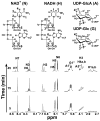Biosynthesis of UDP-glucuronic acid and UDP-galacturonic acid in Bacillus cereus subsp. cytotoxis NVH 391-98
- PMID: 22023070
- PMCID: PMC3240692
- DOI: 10.1111/j.1742-4658.2011.08402.x
Biosynthesis of UDP-glucuronic acid and UDP-galacturonic acid in Bacillus cereus subsp. cytotoxis NVH 391-98
Abstract
The food borne pathogen Bacillus cereus produces uronic acid-containing glycans that are secreted in a shielding biofilm environment, and certain alkaliphilic Bacillus deposit uronate-glycan polymers in the cell wall when adapting to alkaline environments. The source of these acidic sugars is unknown and, in the present study, we describe the functional identification of an operon in Bacillus cerues subsp. cytotoxis NVH 391-98 that comprises genes involved in the synthesis of UDP-uronic acids in Bacillus spp. Within the operon, a UDP-glucose 6-dehydrogenase converts UDP-glucose in the presence of NAD(+) to UDP-glucuronic acid and NADH, and a UDP-GlcA 4-epimerase (UGlcAE) converts UDP-glucuronic acid to UDP-galacturonic acid. Interestingly, in vitro, both enzymes can utilize the TDP-sugar forms as well, albeit at lower catalytic efficiency. Unlike most of the very few bacterial 4-epimerases that have been characterized, which are promiscuous, the B. cereus UGlcAE enzyme is very specific and cannot use UDP-glucose, UDP-N-acetylglucosamine, UDP-N-acetylglucosaminuronic acid or UDP-xylose as substrates. Size exclusion chromatography suggests that UGlcAE is active as a monomer, unlike the dimeric form of plant enzymes; the Bacillus UDP-glucose 6-dehydrogenase is also found as a monomer. Phylogenic analysis further suggests that the Bacillus UGlcAE may have evolved separately from other bacterial and plant epimerases. Our results provide insight into the formation and function of uronic acid-containing glycans in the lifecycle of B. cereus and related species containing homologous operons, as well as a basis for determining the importance of these acidic glycans. We also discuss the ability to target UGlcAE as a drug candidate.
© 2011 The Authors Journal compilation © 2011 FEBS.
Figures






References
-
- Leoff C, Saile E, Rauvolfova J, Quinn CP, Hoffmaster AR, Zhong W, Mehta AS, Boons GJ, Carlson RW, Kannenberg EL. Secondary cell wall polysaccharides of Bacillus anthracis are antigens that contain specific epitopes which cross-react with three pathogenic Bacillus cereus strains that caused severe disease, and other epitopes common to all the Bacillus cereus strains tested. Glycobiology. 2009;19:665–73. - PMC - PubMed
-
- Quelas JI, Mongiardini EJ, Casabuono A, Lopez-Garcia SL, Althabegoiti MJ, Covelli JM, Perez-Gimenez J, Couto A, Lodeiro AR. Lack of galactose or galacturonic acid in Bradyrhizobium japonicum USDA 110 exopolysaccharide leads to different symbiotic responses in soybean. Molecular plant-microbe interactions: MPMI. 2010;23:1592–604. - PubMed
Publication types
MeSH terms
Substances
Associated data
- Actions
- Actions
Grants and funding
LinkOut - more resources
Full Text Sources
Molecular Biology Databases
Miscellaneous

